Undergraduate and Graduate School
Clinical training (November 4th year to March 5th year)
Training Overview
Students who pass the common examinations (CBT, OSCE) administered in their fourth year will undergo practical training as Student Doctors (clinical trainees) in various departments at Hyogo Medical University Hospital from November of their fourth year to March of their fifth year.
In the core medical departments of internal medicine and surgery, clinical clerkships have been introduced, so students become part of a medical team and actually treat patients, acquiring the attitude, skills, and knowledge required of a clinical physician. The content of the training includes participating in rounds and conferences, and observing surgeries, outpatient consultations, and examinations. During this time, with the patient's consent and under the supervision of a supervising physician, students perform medical procedures such as taking blood samples, and assume certain responsibilities as medical students.
In addition, after completing their clinical training, students will have to give a presentation exam on the cases of patients they actually treated during their clinical clerkship, and report the results of their training to their faculty.
After this, clinical training develops into off-campus clinical training and elective training from the end of the 5th year to the first half of the 6th year.
Department of Clinical Practice (FY2015 results)
Clinical Clerkship (Cricla)
- Internal Medicine
- Four of the following subjects for four weeks each
Respiratory Medicine, Rheumatology and Collagen Diseases, Neurology, [Gastrointestinal Medicine, Inflammatory Bowel Disease], Hepatology, Gallbladder and Pancreas, Diabetes, Endocrinology and Metabolism, [Cardiovascular Medicine, Coronary Disease], Hematology, Nephrology and Dialysis, General Medicine
- Surgery
- Two weeks of either one and one week of the other for a total of four weeks
Hepato-biliary-pancreatic surgery, upper gastrointestinal surgery, lower gastrointestinal surgery, inflammatory bowel disease surgery
Polyclinic (Polyclinic)
Emergency and Critical Care Center, Psychiatry and Neurology, Urology, Dermatology, Radiology, Orthopedics, Ophthalmology, Neurosurgery, Otolaryngology-Head and Neck Surgery, Hospital Pathology Department, Sasayama Medical Center, Cardiovascular Surgery, Thoracic Surgery, Pediatrics, Obstetrics and Gynecology, Plastic Surgery, Transfusion and Cell Therapy Department, Clinical Laboratory Department, Infection Control and Prevention Department, Clinical Genetics Department, Dentistry and Oral Surgery, Pain Clinic Department, Anesthesiology and Pain Management Department, ICU, Rehabilitation Department, Public Health, Pediatric Surgery, Breast and Endocrine Surgery
One day training schedule (example)
morning
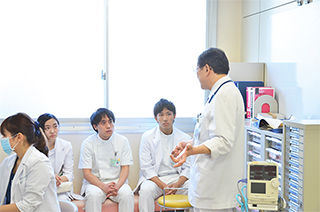
09:00~ Morning Meeting
Observing the supervising doctor's examination at the outpatient clinic
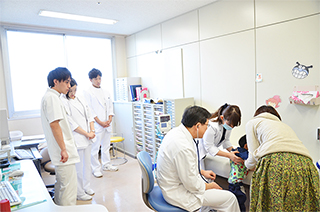
10:40~ Outpatient training
Observing the supervising doctor's examination at the outpatient clinic
12:00~ Lunch break
afternoon
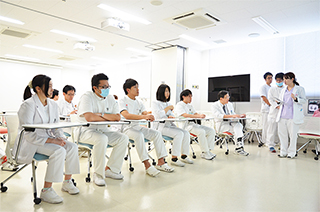
14:00~ Discussion meeting
Each case is reported by the doctor in charge and discussed by the team.
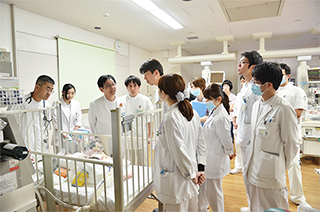
15:00~ General rounds
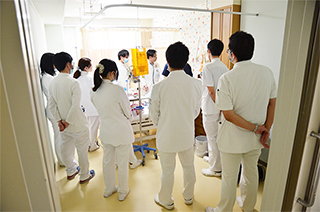
16:00~ Ward training
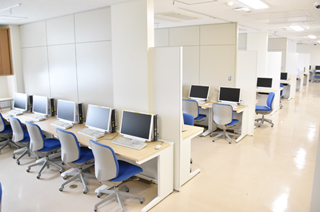
End of training
Electronic medical record training center: record medical records, write reports, self-study
Training Report 5th Year Student (※) Eriko Funatsu
*Grade at time of interview
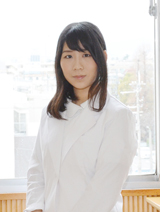
Q: What did you learn during your clinical training?
Going to a real medical site allows you to gain experience that is difficult to obtain through classroom learning alone, and you can learn how to respond to situations that cannot be predicted in textbooks. For example, on the last day of the training in emergency medicine, I visited a fire station and experienced the actual emergency medicine scene, which was a memorable experience, and I learned a lot from the people on the scene.
During my training, the supervising doctors were kind and enthusiastic about teaching me. I was able to touch the actual tools used in each department and use simulators such as endoscopes, and I gained a lot of practical experience under their guidance. In addition, I was able to see my seniors working as doctors up close, and I felt that this is the way I would work in the future.
Communication with patients is also very important in clinical practice. I have learned a lot from patients, and I am grateful for having had the opportunity to do this training.
Q: What are the benefits of doing an internship at Hyogo Medical University Hospital?
I feel that the strengths of our university are its well-equipped facilities and new, clean interior.
The trainees must create electronic medical records to be checked by their supervising physicians, and there is a facility called the "Electronic Medical Record Training Center" just for trainees where they can practice creating these records. By using this facility, the trainees were able to create electronic medical records in a relaxed environment, sometimes consulting with each other.
Q: Is the training difficult?
It is true that it is physically tough. However, doing practical training on-site and writing reports is similar to the work rhythm of a real doctor, so in that sense it wasn't that hard. I also experienced the extremely heartbreaking scene of witnessing "death." There was no small amount of mental anguish, but as a doctor it is something that is unavoidable and must be accepted. I feel it was good that I was able to experience it while I still could.
Q: What medical procedures did you perform?
These tasks include checking vital signs (measuring blood pressure, taking blood samples), suturing, assisting with cerebrospinal fluid collection, and applying bandages.
Q: What are your prospects for the future?
I want to become a doctor who can sincerely and persistently interact with patients and help them relieve their anxiety.